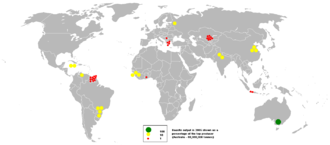Bauxite





Bauxite is a sedimentary rock with a relatively high aluminum content. It is the world's main source of aluminum and gallium. Bauxite consists mostly of the aluminum minerals gibbsite (Al(OH)₃), boehmite (γ-AlO(OH)), and diaspore (α-AlO(OH)), mixed with the two iron oxides goethite (FeO(OH)) and hematite (Fe₂O₃), the aluminum clay mineral kaolinite (Al₂Si₂O₅(OH)₄) and small amounts of anatase (TiO₂) and ilmenite (FeTiO₃ or FeO.TiO₂). Because it is a mixture of minerals, bauxite itself is a rock, not a mineral. Bauxite is typically found in topsoil in various tropical and subtropical regions and is extracted through open-pit mining.
Formation and sources[edit]
Bauxite is formed by the thorough weathering of many different kinds of rocks. Rich sources of bauxite usually contain a specific blend of minerals, including various aluminum oxides and hydroxides. The primary sources of bauxite can be found in countries with tropical or subtropical climates, significant among these are Australia, Brazil, India, and Guinea. The process of bauxite formation is linked to intense leaching of silicate-bearing rocks under tropical conditions, leaving behind oxides and hydroxides of aluminum and other metals, while soluble materials are washed away.
Extraction and refining[edit]
The extraction of aluminum from bauxite is a two-step process. First, bauxite is processed to produce alumina (aluminum oxide) through the Bayer process. In this process, bauxite is mixed with caustic soda (sodium hydroxide) and heated under pressure. The alumina dissolves, leaving behind impurities which are then removed. Following this, the alumina is subjected to an electrolytic process called the Hall-Héroult process, where it is dissolved in molten cryolite and then electrolytically reduced to pure aluminum metal.
Uses[edit]
Aluminum produced from bauxite is used in a wide range of products from airplanes and vehicles to kitchen utensils and foil. It is also used in construction materials, electrical transmission lines, and as an adsorbent or catalyst. Gallium, a byproduct of the alumina refining process, is used in electronics, such as in the manufacture of semiconductors and LED lights.
Environmental impact[edit]
The mining of bauxite can have a significant environmental impact. Open-pit mining, the method most commonly used to extract bauxite, can lead to deforestation, soil erosion, and loss of biodiversity. Additionally, the process of refining bauxite into alumina produces red mud, a highly alkaline waste product that can cause pollution if not managed properly. Efforts are ongoing to find more sustainable mining practices and to reduce the environmental footprint of bauxite extraction and processing.
See also[edit]
Ad. Transform your life with W8MD's Budget GLP-1 injections from $75


W8MD offers a medical weight loss program to lose weight in Philadelphia. Our physician-supervised medical weight loss provides:
- Weight loss injections in NYC (generic and brand names):
- Zepbound / Mounjaro, Wegovy / Ozempic, Saxenda
- Most insurances accepted or discounted self-pay rates. We will obtain insurance prior authorizations if needed.
- Generic GLP1 weight loss injections from $75 for the starting dose.
- Also offer prescription weight loss medications including Phentermine, Qsymia, Diethylpropion, Contrave etc.
NYC weight loss doctor appointmentsNYC weight loss doctor appointments
Start your NYC weight loss journey today at our NYC medical weight loss and Philadelphia medical weight loss clinics.
- Call 718-946-5500 to lose weight in NYC or for medical weight loss in Philadelphia 215-676-2334.
- Tags:NYC medical weight loss, Philadelphia lose weight Zepbound NYC, Budget GLP1 weight loss injections, Wegovy Philadelphia, Wegovy NYC, Philadelphia medical weight loss, Brookly weight loss and Wegovy NYC
|
WikiMD's Wellness Encyclopedia |
| Let Food Be Thy Medicine Medicine Thy Food - Hippocrates |
Medical Disclaimer: WikiMD is not a substitute for professional medical advice. The information on WikiMD is provided as an information resource only, may be incorrect, outdated or misleading, and is not to be used or relied on for any diagnostic or treatment purposes. Please consult your health care provider before making any healthcare decisions or for guidance about a specific medical condition. WikiMD expressly disclaims responsibility, and shall have no liability, for any damages, loss, injury, or liability whatsoever suffered as a result of your reliance on the information contained in this site. By visiting this site you agree to the foregoing terms and conditions, which may from time to time be changed or supplemented by WikiMD. If you do not agree to the foregoing terms and conditions, you should not enter or use this site. See full disclaimer.
Credits:Most images are courtesy of Wikimedia commons, and templates, categories Wikipedia, licensed under CC BY SA or similar.
Translate this page: - East Asian
中文,
日本,
한국어,
South Asian
हिन्दी,
தமிழ்,
తెలుగు,
Urdu,
ಕನ್ನಡ,
Southeast Asian
Indonesian,
Vietnamese,
Thai,
မြန်မာဘာသာ,
বাংলা
European
español,
Deutsch,
français,
Greek,
português do Brasil,
polski,
română,
русский,
Nederlands,
norsk,
svenska,
suomi,
Italian
Middle Eastern & African
عربى,
Turkish,
Persian,
Hebrew,
Afrikaans,
isiZulu,
Kiswahili,
Other
Bulgarian,
Hungarian,
Czech,
Swedish,
മലയാളം,
मराठी,
ਪੰਜਾਬੀ,
ગુજરાતી,
Portuguese,
Ukrainian
